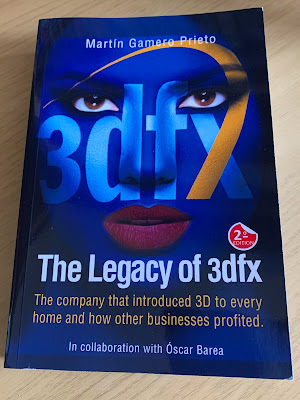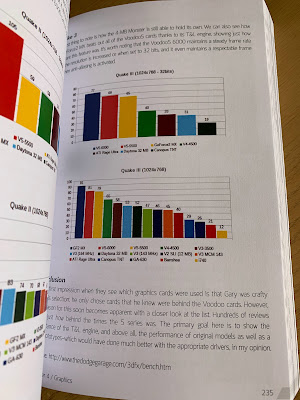The history of personal computing is littered with the names of companies that tried and, ultimately, failed in their endeavours. Whether it was due to hubris, aggressive competition or just plain bad luck, these names deserve to be remembered for at least attempting to make their mark. In this extremely well researched book, Martin Gamero Prieto focuses on a PC graphics industry trailblazer that at one point led the market, and this tome gives us everything you need to know about The Legacy of 3dfx.
 |
| The dust cover. |
The book itself is of high quality and cleanly laid out. Coming in at over 520 pages, there is a lot of detail here, with numerous photographs and diagrams to illustrate the range of cards 3dfx produced. There are also enough charts, tables and graphs to keep even the most ardent Digital Foundry fan happy. A note on the cover too: the jacket looks fairly boring, but the actual book cover is definitely more eye catching.
 |
| The actual book cover |
The first one hundred or so pages give a history of 3D graphics and how the technology developed from its early years in the 1970's and progressed throughout the 1990's. There are sections on the various competitors to 3dfx and how they placed themselves in the ever growing graphics card industry. The next hundred pages detail the range of cards 3dfx produced - there are a lot of them and it is a fascinating looking back at how raw the industry actually was, and how much more interesting it was back then (although that it just my own opinion).
Games pick up the next section, with a focus on titles that benefitted from the new technology and rapidly improving specifications. It's here that you'll also see comparisons between how the various graphics cards competitors to 3dfx performed across a range of titles at the time.
The discussion then switches to the more professional uses the cards were put to, including arcade machines, where the latest 3D graphical technology was used very effectively. There was much more about 3dfx than just the desktop PC. After that, there are a number of sections covering retro PC builds, other platforms and personal commentary.
I found this a very easy read and the translation work is done well, allowing the author's voice to shine through even the most dense of passages. And yes, there is a lot of technical stuff here, but given the nature of the subject, I'd expect nothing less. Concepts are explained in an easy to understand manner and this is definitely a read where you'll come away knowing more than when you first started.
I can honestly say that, whilst I was not much of a PC gamer in the 90's, I did keep up with the tech and trends, and the seemingly dizzying pace of new advancements as the millennium approached. What Martin has done here is put together an excellent history of the 3dfx company and its technology, what made it a market leader and what finally led to its downfall. If the history of PC gaming is your thing, then you really do need to pick up a copy.
The Legacy of 3dfx (English copy) can be purchased directly from the publisher here, and you can follow the them on Twitter here.




No comments:
Post a Comment